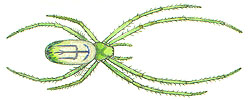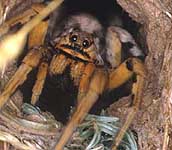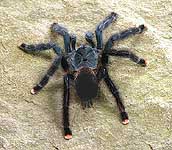 |
|
| You Are Here: Burke Museum : Spider Myths : "Dangerous" : Tarantula |
Myths about "Dangerous" Spiders
Myth: Tarantulas are dangerous or deadly to humans.
 |
 |
| European tarantula Lycosa tarantula Southern Europe; body length 2-3 cm (photo: Manuel J. Cabrero) Click image to enlarge |
Pink toe tarantula Avicularia avicularia Brazil to Trinidad; body length 6-7 cm (photo by Ron Taylor) Click image to enlarge |
| Both the European wolf spiders (left) originally called tarantulas, and the theraphosid spiders (right), often kept as pets and called tarantulas now, have been reputed dangerous to humans. They aren't. | |
Fact: Outside of southern Europe (where the name
is used for a wolf spider, famous in medieval
superstition as the alleged cause of "tarantella" dancing), the word
tarantula is most often used for the very large, furry spiders of the family
Theraphosidae.
Hollywood is squarely to blame for these spiders' toxic-to-humans reputation.
Tarantulas are large, photogenic and most are easily handled, and therefore they have been
very widely used in horror and action-adventure movies. When some "venomous"
creature is needed to menace James Bond or Indiana Jones, to invade a small
town in enormous numbers, or to grow to gigantic size and prowl the Arizona
desert for human prey, the special-effects team calls out the tarantulas!
In reality, the venom of these largest-of-all-spiders generally has very
low toxicity to humans. I myself was once bitten by a Texan species and
hardly even felt it. None of the North American species or those commonly kept
as pets are considered to pose even a mild bite hazard. There have now been a few credible reports of moderate illness from the bites of a few exotic species that are definitely not standard pet store material. However, other people bitten by these same species reported no more than an initial "ouch" and perhaps a little muscle cramping.
The only health hazard posed by keeping pet tarantulas comes from the irritating hairs of the abdomen (in New World species), which can cause skin rashes or inflammation
of eyes and nasal passages. To prevent such problems, simply keep tarantulas
away from your face and wash your hands after handling one.
Compared to common pets such as dogs, tarantulas are not dangerous at all. (For
more information see the American Tarantula
Society).
Myth: Some spiders are deadly.
Fact: There is no spider species anywhere that can properly be called "deadly." Obviously, a few people have died from spider venom, but I know of no species anywhere on earth capable of causing death in humans in as much as 10% of cases, even if untreated. If the person bitten obtains medical aid, death from genuine spider bite ("mystery bites" falsely blamed on spiders don't count) is almost unknown in North America and a decided rarity worldwide. See the next section for a more detailed account of Australian and Brazilian spiders. "Deadly" spiders that can incapacitate you in minutes? Only in the movies!
| Previous Myth | Myths Home | Web Resources | Next Myth |
 |
Text ©
2003-2008, Burke Museum of Natural History & Culture, University of Washington, Box 353010, Seattle, WA 98195, USA Phone: 206-543-5590 Photos © as credited |
Queries
to Spider Myths author, Rod Crawford This page last updated 2 September, 2010 This site best viewed at 800 x 600 using IE 5.0 or above. |